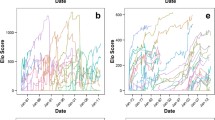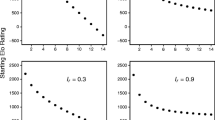Abstract
Establishing the order of a dominance hierarchy among female chimpanzees (Pan troglodytes) is complicated by the fact that they often forage solitarily, and aggressive interactions between them occur infrequently. Authors of previous studies have typically ranked females via the direction of submissive pant-grunts and the outcome of agonistic interactions. Given that higher rank correlates with higher reproductive success in female chimpanzees, assessing rank is important but may be limited by sparsely populated dominance matrices. I tested the hypothesis that rank predicts the direction of female approaches. There is a significant relationship among Gombe females between the frequency with which a female was approached and her dominance rank. Dominant females approached other females less often than they were approached. Though approached frequencies failed to meet the criteria for formal rank indicators, they may be useful as real indicators of subordination. Because approach interactions occur far more frequently than pant-grunts, they may be useful in assigning categorical rank when traditional dominance metrics are limited.

Similar content being viewed by others
References
Altmann, J. (1974). Observational study of behaviour: Sampling methods. Behaviour, 49, 227–262.
Batchelder, W. H., & Bershad, N. J. (1979). The statistical analysis of a Thurstonian model for rating chess players. Journal of Mathematical Psychology, 19, 39–60.
Bygott, D. (1979). Agonistic behaviour and dominance in wild chimpanzees. In D. A. Hamburg & E. R. McCown (Eds.), The great apes (pp. 405–427). Menlo Park, CA: Benjamin/Cummings.
Cheney, D. L. (1977). The acquisition of rank and the development of reciprocal alliances among free-ranging immature baboons. Behavioral Ecology and Sociobiology, 2, 303–318.
Clutton-Brock, T. H., & Gillett, J. B. (1979). A survey of forest composition in the Gombe National Park, Tanzania. African Journal of Ecology, 17, 131–158.
de Vries, H. (1995). An improved test of linearity in dominance hierarchies containing unknown or tied relationships. Animal Behaviour, 50, 1375–1389.
de Waal, F. B. M. (1982). Chimpanzee politics: Power and sex among apes. New York: Harper & Row.
de Waal, F. B. M. (1986). The integration of dominance and social bonding in primates. The Quarterly Review of Biology, 61, 459–479.
de Waal, F. B. M., & Luttrell, L. M. (1985). The formal hierarchy of rhesus macaques (Macaca mulatto): An investigation of bared-teeth display. American Journal of Primatology, 9, 73–86.
Goodall, J. (1986). The chimpanzees of Gombe: Patterns of behavior. Cambridge, MA: Harvard University Press.
Greengrass, E. (2005). Sociability and dominance among female chimpanzees at Gombe. Ph.D. thesis, University of Bristol.
Hasegawa, T. (1990). Sex differences in ranging patterns. In T. Nishida, (Ed.), The chimpanzees of the Mahale mountains (pp. 99–114). Tokyo: University of Tokyo Press.
Isbell, L. A., & Pruetz, J. D. (1998). Differences between vervets (Cercopithecus aethiops) and patas monkeys (Eyrthrocebus patas) in agonistic interactions between adult females. International Journal of Primatology, 19, 837–855.
Jameson, K. A., Appleby, M. C., & Freeman, L. C. (1999). Finding an appropriate order for a hierarchy based on probabilistic dominance. Animal Behaviour, 57, 991–998.
Kitchen, D. M., Cheney, D. L., & Seyfarth, R. M. (2005). Contextual factor mediating contests between male chacma baboons in Botswana: Effects of food, friends, and females. International Journal of Primatology, 26, 105–125.
Koyama, N., Ichino, S., Nakamichi, M., & Takahata, Y. (2005). Long-term changes in dominance ranks among ring-tailed lemurs at Berenty Reserve, Madagascar. Primates, 46, 225–234.
Muller, M. N. (2002). Agonistic relations among Kanyawara chimpanzees. In C. Boesch, G. Hohmann, & L. F. Marchant (Eds.), Behavioural diversity in chimpanzees and bonobos (pp. 112–124), Cambridge, UK: Cambridge University Press.
Murray, C. M. (2006). The Influence of feeding competition on foraging strategies, grouping, and ranging patterns in wild chimpanzees (Pan troglodytes). PhD thesis, University of Minnesota.
Nishida. T. (1989). Social interactions between resident and immigrant female chimpanzees. In P. G. Heltne & L. A. Marquardt (Eds.), Understanding chimpanzees Cambridge, MA: Harvard University Press.
Noldus Information Technology (2003). Matman, version 1.1. The Netherlands: Wageningen.
Parr, L. A., Matheson, M., Bernstein, I. S., & de Waal, F. B. M. (1997). Grooming down the hierarchy: Allogrooming in captive brown capuchin monkeys, Cebus apella. Animal Behaviour, 54, 361–367.
Perry, S. (1996). Female-female social relationships in wild white-faced capuchin monkeys, Cebus capuchinus. American Journal of Primatology, 40, 167–182.
Pusey, A. E., Williams, J. M., & Goodall, J. (1997). The influence of dominance rank on the reproductive success of female chimpanzees. Science, 277, 828–831.
Seyfarth, R. M. (1977). A model of social grooming among adult female monkeys. Journal of Theoretical Biology, 65, 671–698.
Sterck, E. H. M., Watts, D. P., & van Schaik, C. P. (1997). The evolution of female social relationships in nonhuman primates. Behavioral Ecology and Sociobiology, 41, 291–309.
Range, F., & Noë, R. (2002). Familiarity and dominance relations among female sooty mangabeys in the Taï National Park. American Journal of Primatology, 56, 137–153.
van Hoof, J. A. R. A. M., & Wensing, J. A. B. (1987). Dominance and its behavioral measures in a captive wolf pack. In H. Frank (Ed.), Man and wolf (pp. 219–252). Dordrecht: Dr. Junk Publishers.
Walters, J. R., & Seyfarth, R. M. (1987). Conflict and cooperation. In B. B. Smuts, D. L. Cheney, R. M. Seyfarth, R. W. Wrangham, & T. T. Struhsacker (Eds.), Primate societies (pp. 306–317) Chicago: University of Chicago Press.
Watts, D. P. (1994). Agonistic relationships between female mountain gorillas (Gorilla gorilla berengei). Behavioral Ecology and Sociobiology, 34, 347–358.
Wittig, R. M., & Boesch, C. (2003). Food competition and linear dominance hierarchy among female chimpanzees of the Tai National Park. International Journal of Primatology, 24, 847–867.
Wrangham, R. W., Clark, A. P., & Isabirye-Basuta, G. (1992). Female social relationships and social organization of Kibale Forest chimpanzees. In T. Nishida, W. C. McGrew, P. Marler, M. Pickford, & F. B. M. de Waal (Eds.), Topics in primatology (pp. 81–98). Tokyo: University of Tokyo Press.
Wrangham, R. W., & Smuts, B. B. (1980). Sex differences in behavioural ecology of chimpanzees in Gombe National Park, Tanzania. Journal of Reproduction and Fertility, 28, 13–31.
Acknowledgments
I thank Tanzania National Parks, the Tanzania Wildlife Research Institute, and the Tanzanian Council for Science and Technology for granting me permission to work in Gombe National Park. I also thank the Gombe Stream Research Center for maintaining long-term data collection and the Jane Goodall Institute for providing field assistants (S. Athumani and M. Msafiri) for this study. Finally, I thank I. Gilby, E. Lonsdorf, A. Pusey, and 2 reviewers for helpful comments on an earlier version of the manuscript. A grant from Milton Harris, a Dayton-Wilkie Fellowship, the Jane Goodall Institute, and the Graduate School at the University of Minnesota funded the work.
Author information
Authors and Affiliations
Corresponding author
Rights and permissions
About this article
Cite this article
Murray, C.M. Method for Assigning Categorical Rank in Female Pan troglodytes schweinfurthii via the Frequency of Approaches. Int J Primatol 28, 853–864 (2007). https://doi.org/10.1007/s10764-007-9164-2
Received:
Revised:
Accepted:
Published:
Issue Date:
DOI: https://doi.org/10.1007/s10764-007-9164-2




